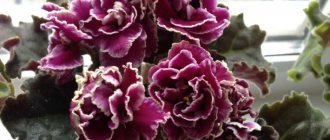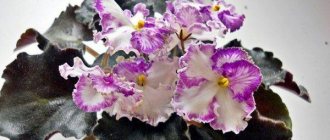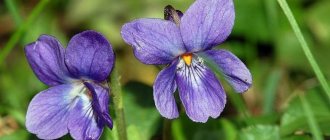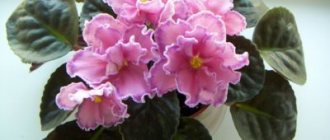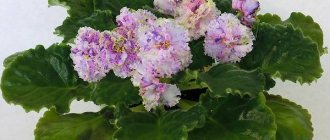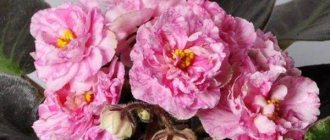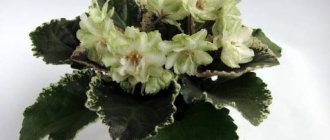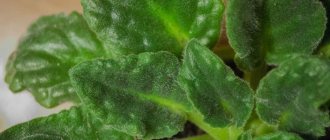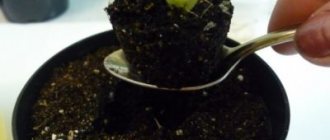The Jan Minuet violet has recently become a very popular plant. This is a very beautiful flower that is gaining popularity every year. All this happens because of its very interesting and attractive appearance. The plant also has a pleasant smell that spreads throughout the apartment.
This plant comes from Ghent and was bred by breeders for a special exhibition. At this exhibition, the plant took pride of place, so it began to be distributed throughout the world. In Germany, this flower is considered a masterpiece created by breeders.
Violet, description and photo Jan-Minuet (N. Puminova)
Violets from breeders of the CIS countries - “M” (Yan).
Jan- Minuet (N. Puminova).
Ian-Minuet' (N. Puminova).
Large light pink terry stars with a crimson wavy border.
Pointed green quilted leaves. Standard. The biggest problem is that the outlet constantly keeps its hands up. An even rosette is obtained only when the violet is on the windowsill, and there is also lighting from above.
Large white-pink double and semi-double flowers with a bright crimson border. The wavy petals are not very densely spaced and add airiness to the flower. The tenderness and airiness of the flowers is given by the light pink, almost white with a pink tint, the main background of the flower, and the raspberry border-spraying along the wavy edge of the petal makes the flower bright. In varieties of different lines, as well as from flowering to flowering, the width of the border can vary. The border does not fade and the flowers last long enough.
It is most beautiful in the third flowering, the flowers become larger, fuller and brighter. The fullness of the flowers will increase if they are placed on a windowsill in spring and summer, and the age of the rosette, of course, matters. The size of the flowers is quite large, up to 6 cm. The flowers retain their freshness for quite a long time.
Abundant cap flowering, friendly opening of buds and a good bouquet. The variety is a tireless bloomer and each subsequent flowering is more abundant. It blooms often, with breaks of one month, and again with a head of flowers. Peduncles are tall, long, collected in a bouquet. There are up to 3 flowers on the peduncle.
An easy-to-care and unpretentious variety, it grows quickly, blooms quickly, and is not greedy for children. This variety needs good bright light, light for at least 12 hours a day. It grows well and beautifully only in those who have a lot of light. Likes more abundant watering than other varieties.
A variety for windowsills; when flowering on a shelf, the rosette of the paws lifts up, the flowers turn pale and do not terry at all. After abundant flowering, it likes to replant, this is necessary so that the leaves do not begin to turn yellow.
Propagates well from leaf cuttings. Babies appear quite quickly. The variety blooms early. There is a sport with curly leaves, the flowers are smaller than the variety, darker and have a brown ruffle along the edge of the petals.
The minuet is an ancient French ballroom dance characterized by smooth and slow movements and consisting mainly of bows and curtseys, as well as music to the rhythm of this dance.
Do you know that…?
You cannot use drugs of the first and second hazard classes in apartments. The toxicity of pesticide vapors in enclosed spaces is the evaporation of the drug. Penetrating into the human lungs, toxic chemicals are immediately absorbed into the blood, bypassing the liver barrier, spread throughout the body, immediately poisoning the brain and other internal organs. Every substance, even solid ones, can evaporate. The lower this indicator, the weaker the volatility, and therefore the less harmful the drug is to the lungs.
At high temperatures it evaporates faster, so in the initial period the vapor concentration will be higher, but with good ventilation in the following days the vapor concentration will already be much lower than at a lower temperature. At a lower temperature, volatility is lower, the drug also decomposes worse, which means that the dangerous concentration of vapors will stretch over a longer period.
Before you buy the violets listed below, carefully read the forums about their behavior on the windowsill. Many of them are very beautiful flowers. However, these can be large rosettes with large and fragile leaves, with leaves rising up or hugging the pot, forming many stepsons that interfere with the formation of a neat rosette, pulling the stem up and growing into a Christmas tree, bending the trunk, rare flowering with long breaks, fallen flowers or they last little and quickly wither, very long and recumbent peduncles, the color of the flower fades quickly, they do not like bright lighting on the windowsill, they are afraid of the slightest drying out or waterlogging, a large percentage of them go into sports or darken the flower.
Are they suitable for your window sill and the conditions that you can create for them? You will look at the flowers for several months, and the rosette will always be in front of your eyes. There are many beautiful flowers, there are much fewer beautiful and neat rosettes, look first at the rosette! Search and you may find a dozen violets with the same flower color if you are not interested in the smallest details as a collector.
Possible difficulties during cultivation and their solutions
When growing Saintpaulia, many gardeners encounter typical problems, the main cause of which is improper care.
Timely detection of errors allows you to correct the situation:
- Changes in the shade and structure of the leaf plate. The appearance of spots or rot on leaf plates, or a change in the basic shade indicates a lack or excess of light. In addition, too high a room temperature can cause a change in the shade of the leaves. If no pests are found on the plant, then a change in the shade of the leaf blade and the appearance of putrefactive spots may indicate the development of an infectious or fungal disease.
- Leaf rosette growth. Excessive exposure to too bright light and long daylight hours often lead to the growth of a leaf rosette. The appearance of additional shoots in the center of the rosette may prevent further development of buds. To avoid this, you need to move the violet away from artificial light or shade it if it is on a windowsill and receives maximum sunlight.
- Lack of flowering. The problem that novice gardeners face includes the complete failure of violets to form buds. This is caused by an excess of complex fertilizers with a high nitrogen content. Nitrogen causes plants to grow green mass, which prevents the timely formation of buds.
- Lack of flower stalks, development of stepsons. A common problem of choosing the wrong pot for planting leads to the growth of violets. This means that stepsons develop from the axillary leaves, which interfere with the formation of peduncles. This problem can be solved by removing the stepsons and transplanting the flower into a container of smaller diameter.
- The leaves turn inward. This phenomenon can be observed when the air temperature in the room is elevated. Turning up the leaves can cause long daylight hours if the violets are outside. The mechanism of this phenomenon is based on overheating of the leaf plate and receiving an excessive amount of light. This provokes the violet to tuck the leaf blade inward to protect it from the sun. The solution to the problem is to move Saintpaulia to a cooler room and reduce daylight hours. To speed up the normalization process, you can use a technique in which a pot of violets is covered with the cut part of a dark plastic bottle.
- The appearance of mold on the leaves. Mold appears on the leaves in cases where the plant becomes sick with gray or white rot. Infections develop when the air temperature in the room drops below + 16°. The disease is provoked by excessive watering and high humidity. To remove gray or white rot, the plant is treated with fungicides with a high copper content.
- Lengthening petioles. Too long petioles are formed in Saintpaulia if it does not have enough light and heat. Violation of the temperature regime provokes the growth of the petiole, but at the same time slows down the formation of buds and the correct formation of a leaf rosette.
- The appearance of a mosaic pattern on the leaves. A mosaic pattern on the leaves indicates a lack of iron. This problem can be solved by adding organic complexes. In addition, a mosaic may appear on the leaf blade due to the development of infectious or fungal diseases.
The violet, which belongs to the Jan Minuet variety, is a classic example of a member of the Saintpaulia family. Photos of the variety’s graceful and delicate buds force novice gardeners to choose this flower for growing.
Description of violet Jan Minuet
The emerald-colored leaves have a wavy border and sharp edges. In the center of the rosette flowers bloom with a terry surface, shaped like stars. They are mostly light pink with rich crimson trim of varying sizes.
The flower reaches seven centimeters in diameter. Due to the fact that the petals in the flower are not very densely arranged, the inflorescence seems light and airy. Each long and powerful peduncle produces up to three flowers.
This variety stands out clearly from other violets with its petals.
Jan-Menuet differs from other varieties of violets in its bright and more noticeable color transitions on large curly petals.
Flowers retain their freshness and presentable appearance for a long period. Usually “Jan Minuet” pleases flower growers for about nine months. There is a month break between flowering.
Each subsequent flowering is brighter and more abundant than the previous one, the flowers become larger and double. If you place this variety next to blue and ruby varieties, you will get a wonderful floral ensemble.
This variety has a small peculiarity: the violet leaves constantly stretch upward . This deficiency can be corrected by observing all necessary conditions of detention. It is necessary to maintain the correct temperature and provide the plant with vital sunlight.
The rosette of the variety will turn out even only when kept on a windowsill. If you place a pot with a plant on a shelf, the leaves will begin to stretch upward, the flowers will lose their fullness and turn pale. Sometimes additional lighting will be required to maintain an even outlet.
Description of the variety
Saintpaulia “Yan Minuet” is a double variety.
Leafy rosettes of a bright emerald hue favorably emphasize the beauty of star-shaped inflorescences of a soft pink hue.
During flowering, Saintpaulia “Yan Minuet” will delight you with its delicate aroma in addition to its attractive appearance.
Peculiarities! The star-shaped inflorescences have a characteristic crimson border.
History, who bred
Violet “Jan Minuet” was bred in 2006 by Russian breeder N.A. Puminova. It is part of the “YAN” series.
Leaves
The leaf rosette is large. The leaves are quilted, have an emerald green color and a wavy border along the edges. The rounded shape is emphasized by sharp edges.
It is important to observe the recommended temperature and lighting so that the young plant develops a beautiful rosette.
If the air is too hot or there is insufficient lighting, the socket may stretch out unsightly.
Flowers
The star-shaped flowers are large; with good care they reach 7–9 centimeters in diameter.
The color is light pink, with a wavy crimson edging, as in the photo on the left. Collected in lush inflorescences.
The peduncles are strong, each producing 3 flowers.
Reference! The main distinguishing feature of this variety is the unusual color of the petals. It is characterized by unusual, “watercolor” transitions from a pale pink hue in the middle to crimson at the edges.
The continuous flowering period is 10 months. After this, the plants need to be given a month of rest.
Features and differences from other varieties
Despite the complexity of cultivation and care, “Yan Minuet” is suitable even for beginners. Flowers are able to maintain an aesthetic appearance and freshness for a long time. Moreover, each subsequent flowering will be brighter and more abundant than the previous one.
Home care
The variety "Jan Minuet" is considered a sensitive and delicate variety . Despite this, caring for the plant does not require much effort. Even a beginner can grow a specimen of this variety.
Lighting and temperature
The violet needs plenty of sunlight, but without direct rays, which can leave burns on the delicate leaves. “Jan Minuet” requires temperatures ranging from twenty to twenty-four degrees.
Proper temperature control is extremely important for healthy violet flowering.
The lower value is comfortable for mature plants with large flowers. Young specimens that are just gaining growth need higher temperatures.
During the winter months, a violet placed on a windowsill provides warmth.
If the plant is on a stone windowsill, the roots must be protected from freezing by using a special stand that is placed under the pot.
Watering and humidity
Water the violet regularly, preventing the substrate from drying out. There are two ways to organize watering: the method from above or from below, that is, by using a tray.
To avoid rotting, do not get water on the rosette of the flower.
The first method: carefully pour water along the edges of the pot, trying not to erode the top layer and not get on the rosette , leaves and flowers. It is most convenient to use a small watering can with a long narrow spout.
Watering is continued until water begins to pour out of the holes in the container into the pan. After half an hour, the water is removed from the pan so that it does not cause rotting of the roots.
Second method: water is poured into a tray. From there it is gradually taken away by the plant. This method has a big drawback: salts that are dangerous to the plant accumulate in the pot and are not washed out. They can lead to the death of the violet.
The correct organization of watering is checked by the appearance of the violet. A plant that receives a sufficient, but not excessive amount of moisture looks healthy: the leaves are colored rich green and feel quite elastic to the touch.
Soft, drooping leaves that hang over the edge of the planting container indicate dry soil. In such a situation, the violet needs to be urgently saved.
The pot is placed in a container with warm water so that the water reaches the middle, and placed in the shade, covered with polyethylene film. In a day the violet will return to normal .
| Seasonality of watering | |
| In summer | The violet is watered about two to three times a week, making sure that the top layer of soil dries out before the next watering. |
| in winter | the substrate is moistened less frequently, the next watering is organized only after the top soil has completely dried |
Violets of this variety are naturally found on the coasts of streams and rivers, that is, in areas with high levels of humidity.
Growing conditions
Saintpaulia “Yan Minuet” is a delicate plant that is quite sensitive to care conditions. But with strict adherence to the breeding and care algorithm, even a novice gardener can grow it.
We think you will be interested in the description of other varieties: violet “Blue Dragon”, violet “Blue Fog”, violet “Esmeralda”, violet “Lituanica”, violet “Cinderella’s Dream”, violet “Olesya”, violet “Summer Twilight”, violet “ Chanson", violet "Ice Rose" and others
Priming
To make the plant feel comfortable, a special soil mixture and good drainage are needed.
For this, ready-made soil for violets is often used.
The nutritional mixture is also prepared independently. For it you will need:
- forest land - 3 parts;
- sand - 3 parts.
- peat – 5 parts.
The soil should be light and loose. To do this, it is recommended to add charcoal to the mixture.
Pot
The best option would be a wide but not deep plastic pot. It is not recommended to use clay or ceramic bowls. The soil in them dries out faster, which is bad for plants.
Attention! You cannot use previously used pots to replant plants 2 times in a row. Salt deposits form on their inner walls over time. This will lead to weakening of the plants.
Lighting
In order for violets to bloom constantly and abundantly, they need a large amount of sunlight. But direct sunlight should not be allowed, as this will lead to burns on the leaves.
Temperature
The optimal temperature for growing is 20 – 24 C.
The plant does not tolerate any temperature changes. Because of this, it should be protected from drafts and cold air during ventilation.
For young plants, the room temperature should not fall below 22 - 24 C , this will have a bad effect on their health.
Carefully! If violets stand on a stone windowsill in autumn and winter, this can lead to hypothermia of the roots. A special stand for pots will help avoid this.
Humidity
For plants to be healthy and bloom vigorously, they need high humidity. “Jan Minuet” does not tolerate drought well, this leads to wilting of the leaf rosettes.
It is recommended to place a hygrometer near the plants to monitor air humidity. The optimal indicator would be 60 – 70%.
If the air is dry, the situation can be corrected in one of 2 ways:
- spraying warm water next to the plants from a spray bottle;
- placing pots on trays of water.
Since the leaves of the plant are densely pubescent, water should not fall on the leaves when spraying. Also, do not allow drops of water to get on the flowers. During the flowering period, it is advisable to additionally moisten the plants only using trays of water.
Reference! The natural habitat of such violets is the river bank, which is why they need constant moisture.
Transfer
"Jan Minuet" is recommended to be replanted in the spring. Exceptions are cases when the plant dies and urgent resuscitation .
The correct way is to transship the plant when it is replanted with an old earthen lump
To begin with, place drainage consisting of sphagnum moss or expanded clay and a little soil at the bottom of the pot. Then the violet is carefully removed from the old pot. Damaged or diseased leaves and roots are removed, excess soil is carefully removed from the earthen ball and placed in a new pot.
The violet is placed in the middle and the roots are straightened. Then the gaps between the earthen lump and the edges of the pot are filled with new soil, trying not to hit the growing point .
Watering
To successfully grow this crop, it is necessary to provide regular watering to prevent the earthen clod from drying out. This can be done in two ways - from above or from below (from the pallet). In the first case, water is poured near the edge of the pot in such a way as not to erode the surface of the soil and not to wet the young tender leaves of the plant. For convenience, it is better to use a watering can with a long narrow spout. Water until water begins to come out through the drainage holes in the pot. After about half an hour, it is drained from the pan to eliminate the possibility of root rotting.
When watering from below, water is poured into a tray, from where it is gradually absorbed by the plant. This method has a significant disadvantage - harmful salts accumulate in the earthen coma over time, which can cause the flower to wither.
For irrigation, ordinary tap water is used, which is left to settle in an open container for two days.
The Jan Minuet violet can tell by its appearance how well the watering is done. Elastic, richly colored leaves indicate sufficient moisture. If they become soft, hanging over the edge of the pot, it means the soil is dry and the plant needs urgent help. The pot should be placed halfway in warm water for an hour and a half and placed in the shade, covered with plastic wrap. After about a day, the plant is completely restored.
Reproduction
Violet variety "Jan Minuet" is propagated by cuttings, leaves, peduncles or stepsons. The most common method of propagation is leaves. In spring or summer, on a healthy violet, choose a young leaf of rich color and without damage, located in the second or third row of the rosette.
The leaf is cut at an angle of forty-five degrees, and the cut area is sprinkled with activated carbon. The leaf is placed in soft water and placed in a warm room until roots form. After the roots appear, the young plant is transplanted into the soil .
Cut the propagation leaf with a sterile instrument!
Violet is a flower that is quite popular among our compatriots. Breeders even bring their unique species for sale throughout Russia. If you are interested in this home flower, we recommend reading about its history and finding out where the Violet comes from.
The variety "Jan Minuet" is quite common among flower growers and takes pride of place in collections. Delicate and beautiful flowers delight responsible owners for a long time, who comply with all the conditions necessary for the plant.
Diseases and pests
Decorative indoor violets are susceptible to infectious diseases and invasions of insect pests, so gardeners often include preventive treatments with insecticides or fertilizing with immunocytophyte in their care program.
| Treatment | When to treat |
| Systemic insecticides | After leaving the dormant phase, before flowering. |
| Immunocytitis | After flowering, removing dried parts and dead buds. |
The variety Jan Minuet is susceptible to the following diseases:
- Late blight. A disease that primarily affects the root system. Late blight can be diagnosed by the formation of purple-brown spots on leaves and stems, wilting of the leaf rosette, and lack of flowering. Rot, which affects the roots, spreads throughout the stem and destroys the flower.
- Gray and white rot. These are types of infectious diseases that develop due to moisture stagnation or incorrect temperature settings. Gray and white rot are detected by the presence of characteristic spots on leaf blades, rapid withering of young leaves, and falling buds.
- Powdery mildew. A fungus caused by soil-dwelling pathogens. The disease can be triggered by a violation of temperature or watering conditions, and also often develops due to improper preparation of the soil mixture used during plant replanting.
The fight against infectious diseases is carried out using any suitable methods. For Saintpaulia, partial treatment of the above-ground part and the use of insecticidal substances when watering at the root are suitable. If more than 30% of the above-ground part is affected, then an unplanned transplant is necessary to save the violet from death.
The following pests often cause damage to violets:
- Scaleworms. Small white insects that look like worms. They appear on leaf petioles or reproduce on the reverse side of the leaf blade. Scale insects can be detected by the presence of a sticky secretion that sticks the leaves together.
- Whiteflies. Insects feeding on the cell sap of violets. The danger is not from the adults, but from the eggs that the females quickly lay on the inside of the leaf blade. An invasion of whiteflies can stop the growth of leaf rosettes and bud formation.
- Cyclamen mite. One of the most dangerous parasites for violets. Signs of damage can be considered the development of fragility and fragility of leaf blades, falling off of buds, and the presence of light microscopic dots on the leaf blades that appear after a tick bite. The cause of the appearance of mites may be increased air temperature and low humidity.
To get rid of insects, the plant is treated with a solution of laundry soap, specifically washing the leaf blades from the inside. To get rid of ticks, Saintpaulia is watered with acaricidal preparations. They are able to rid the plant of adult individuals and destroy ovipositors.
Jan-Minuet, N.A. Puminova
Found a mistake? Report it: 1) Select the error with the mouse 2) Press CTRL+Enter. Read more.
Violet Ya n-Menu et , N.A. Puminova
Large light pink terry stars with a crimson wavy border. Green quilted leaves. Standard. 2006 (author's description)
Ian-Minuet' (10107) 07/08/2009 (N. Puminova) Semidouble-double light pink large wavy star/thin raspberry edge. Medium green, pointed, quilted. Standard (Russ/Ukr) (AVML Catalog)
Story
The “Yang Elegant” violet was bred by a famous breeder from Moscow, Natalya Aleksandrovna Puminova. For many years she has been breeding and selecting her favorite plants, bringing new varieties of violets to perfection. The prefix “yang” in the name of the variety is Puminova’s “trademark”. This is how the names of other varieties of Natalya Alexandrovna’s selection begin. Admire this “yang elegant” violet. The photos will not leave lovers of indoor plants indifferent. Do you already want such a beauty for your windowsill?
Properties
Name
- Original: Jan-Minuet
- Transcription:
- Translation:
Registration
- Selection: N.A. Puminova
- Year: 2006
Socket
- Socket type: standard
Flower
- Flower size, up to: 7 cm
- Flower shape: star
- Terry size: semi-double, terry
- Main color: light pink
- Type of painting: two-tone
- Border: plain
- Other features:
Foliage
- foliage color: medium green
- foliage type: simple
- foliage shape: pointed, heart-shaped; quilted
- reverse of sheet: silver
- leaf edge: jagged edge
- variegation:
Peculiarities
Quite a popular variety and beloved by many collectors. The flowers of this variety are delicate, airy and bright at the same time. The tenderness and airiness of the flowers is given by the light pink, almost white with a pink tint, the main background of the flower, and the raspberry border-spraying along the wavy edge of the petal makes the flower bright. In varieties of different lines, as well as from flowering to flowering, the width of the border may vary. The flower shape is a double star. When fully bloomed, the flower size reaches 7 cm. There are up to three flowers on the peduncle. The peduncles are tall, quite strong, collected in a bouquet. The variety blooms early, blooms often and abundantly. Flowers retain their freshness for quite a long time.
An even rosette of quilted medium green leaves. The big drawback of this variety is its need for a balance of adequate light and cool temperatures. The leaves of the rosette pull “hands up” both in good lighting, but elevated temperature on the shelf, and in lack of light, but comfortable temperature on the windowsill. In order for the outlet to be smooth and not pull “hands up”, good daylight and coolness are preferable. Otherwise, the variety is easy to care for. Propagates well from leaf cuttings. The babies grow quickly and bloom early. Sports are very rare. Beginning collectors need to take into account the features of this variety in order to form a good rosette.
What does the Caprice violet look like in the photo?
We can say that this violet is not very photogenic. Creamy white flowers with a pleasant greenish fringe along the edge almost blend in color with the leaves.
It can even be difficult to see them in the photo. A rosette without flowers looks very beautiful and original. Nevertheless, amateur flower growers are trying to create this whim on their windowsill. As in any other case, there are so many people, so many opinions.
Regarding this variety, there are both disappointed and enthusiastic admirers.
Reviews
Alina Akzigitova. I’ve only recently acquired this variety, but it’s already one of my favorites. In my conditions of an eastern window and long daylight hours, the rosette begins to “hugging” the pot. The socket is still young, the starter. The first flowering in the extreme heat this summer is not a bouquet. But we will wait for the hat, I hope. I noticed that it differs from other varieties - it likes to drink more than others. One photo, but what kind is there?
.
- Login or register to post comments
Humidity
This variety of violets grows in natural conditions mainly along the banks of rivers and streams, where the air is saturated with moisture. The humidity level for this plant should not be lower than 60%. In apartments with central heating, it is necessary to increase it in order to create a favorable microclimate for violets. This can be done in various ways:
- Place the flower pot in a flat vessel like a metal baking tray, into which pour water. As it evaporates, it will increase the humidity in the air surrounding the plant.
- Using a spray bottle, you can spray water near the plant. Due to the fact that Jan-Menuet (the violet described here) has too much pubescence, spraying the leaves and flowers is not recommended.
Comments
A big request to the owners of this variety! Please add your photos and write reviews. The variety is no longer new, but still remains interesting and popular. In addition, the variety is not very simple. I would like to collect more information here about the successes and failures in growing this variety. In order to add your photos, you need to click on the word “Edit” in the very top line above the article. And then everything is the same as in writing a regular article. Add a photo. In the “Reviews” section, write your impressions about the variety. And don't forget to save the added information. Thanks in advance everyone!
Nuances of violet care
Each plant requires special care and creation and is no exception.
- Light. Despite the fact that violet leaves are resistant to fading, direct sunlight has a negative effect on it. Violet is very photophilous, but it is accepted, develops and blooms only in diffused light. The lack of light, as well as its abundance, causes inhibition of all plant production processes. The optimal time to saturate the violet with light is 12 hours.
- Warm. A temperature of +21°C is recognized as the best for growing violets. It is recommended by experts, since consistency in room temperature is the key to a strong plant. If you grow violets in a room where the temperature is below normal, the color scheme will change towards increasing the size of the edges. When a violet is grown in conditions of elevated temperature, this leaves an imprint on subsequent offspring and the size of the fruit.
Irrigation involves several nuances that must be observed.
To water a flower, you do not need a special liquid: you can use tap water to irrigate the surface. In such cases, a procedure is carried out to remove all elements that adversely affect the condition of the flower. To do this, the water is allowed to settle for 48 hours, then boiled and cooled. In order for irrigation to bear fruit and not harm the soil and plant, the water for irrigation must be at a higher temperature than the surrounding atmosphere
To determine the correct selection of water temperature, you should check the soil - it must also be warm.
Caution must be exercised directly when watering. Water getting on the leaf and its stem can cause rotting, so the following method is practiced: after watering the top layer, the container with the plant is placed in a tray with warm water.
Root rot is an extremely dangerous thing.
In this regard, after a quarter of an hour has passed, the tray with liquid is removed. If you are unsure of the dose of water consumed by violets, experts recommend choosing the smallest volume. This is explained by the fact that violet tolerates dryness more resistantly than excess moisture. In addition to caring for the soil, gardeners recommend rinsing violet leaves with warm water. Twice in one season of the year is a completely feasible process.
Air humidity. Unripe violets are very difficult to tolerate a dry climate, just like transplanted plants. It is tolerated stably and easily by mature violets, accustomed to the conditions of this environment. To create more fertile soil for the plant, a greenhouse effect is created by covering the flowers with glass or polyethylene. It happens that evaporation appears on the surface of the plant. This may be the result of fungal diseases, so in such cases the room should be ventilated. To eliminate the cause in advance, you should not exceed the air humidity level of 70%.
Favorable soil. In order for the plant to develop, it is necessary to provide it with loose and saturated soil. Soil can be purchased in special stores or collected personally. To create soil with your own hands you will need: 3 parts of rotted marsh plants, 5 parts of leaf soil, 1 part of perlite and a tenth of the total mass of coal. Due to such a diverse composition, excess moisture is eliminated and the humidity of the local indoor climate is maintained.
Capacity. The most suitable for violets are pots made of expanded clay or plastic. They guarantee the plant protection from air and elimination of water.

